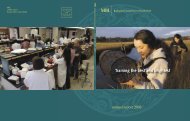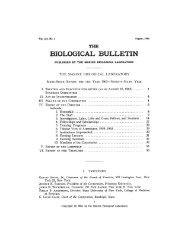General embryological information service - HPS Repository
General embryological information service - HPS Repository
General embryological information service - HPS Repository
Create successful ePaper yourself
Turn your PDF publications into a flip-book with our unique Google optimized e-Paper software.
.<br />
model includes periodic "pacemakers" and provides "regulation" without additional<br />
assumptions.<br />
The discussion in ch.6 is likewise based on the notion of wave propagation.<br />
The chapter has sections on periodic patterns, on the insect epidermis, on<br />
the chick wing bud (with a wave model for epimorphosis) , on imaginal discs<br />
and the insect limb (with an interesting elaboration of the "clock-face"<br />
model of French et at.), and on retino-tectal projection in amphibians. The<br />
author concludes by saying that the notion of static diffusion gradients<br />
providing positional <strong>information</strong> will probably have to be replaced by a combination<br />
of wave propagation from defined organising centres, and (local or<br />
global) "clocks" of some kind which generate spatial and temporal periodicities.<br />
There is much more in the book (particularly in the last chapter) than can<br />
be done justice to here. The author aspires after a "balance between knowledge<br />
and vision", and to grasp the significance of this the perusal of the<br />
entire book is necessary (even though for the average biologist the going is<br />
difficult in places)<br />
9.<br />
G.NICOLIS and I.PRIGOGINE. 1977. SELF-ORGANIZATION IN NONEQUILIBRIUM SYSTEMS;<br />
from dissipative structures to order through fluctuations<br />
Wiley, New York, etc. XIV, 491 pp., 124 figs., subject index. £ 20.75<br />
Contents (abridged): I. The thermodynamic background (4 chs.); II. Mathematical<br />
aspects of self-organization: deterministic methods (4 chs.); III.<br />
Stochastic methods (4 chs.); IV. Control mechanisms in chemical and biological<br />
systems (4 chs.); V. Evolution and population dynamics (2 chs.)<br />
On reading the word self-organisation every embryologist pricks up his<br />
ears. Unfortunately this reviewer lacks all competence in mathematics, and<br />
all I can do here is to try and highlight the main features of this book and<br />
of its authors' thinking in order to bring them to the attention of developmental<br />
biologists. (In this notice I will often use or paraphrase the words<br />
of the authors without showing this by quotation marks.)<br />
Most of the striking results of classical thermodynamics refer to equilibrium<br />
situations. Later, linear nonequilibrium thermodynamics showed that<br />
nonequilibrium may be a source of macroscopic (global) order (the example<br />
adduced by the authors is thermal diffusion.) The results of the investigations<br />
by Prigogine's group on situations further away from equilibrium, and<br />
involving nonlinear equations, can be sketched as follows. When a system<br />
(e.g. a chemically reacting mixture described by nonlinear functions of the<br />
variables involved) is forced further and further away from equilibrium, the<br />
equilibrium solution may become unstable and the system may evolve toward a<br />
new type of organisation (a new long-range molecular order) involving coherent<br />
space-time behaviour (cf . the Benard instability in liquids) . This type<br />
of organisation depends on appropriate feedback conditions; the new structures<br />
that appear can be maintained only through a sufficient flow of energy<br />
and matter and are called "dissipative structures". (Turing's early work<br />
concerned one of the first dissipative structures ever studied.)<br />
The special interest of the biological applications of this approach discussed<br />
in the book is brought out by the following quotation,: "While each<br />
of the important biomolecules discovered in the recent years is obviously<br />
formed according to the laws of physics and chemistry, we have to identify<br />
the mechanisms that make the "mass production" of these molecules possible<br />
and coordinate their production according to the needs of the organism. It<br />
has often been stated that biological organisation requires a series of<br />
structures and functions of growing complexity and hierarchial character.<br />
One of our main concerns is to understand the way in which transitions between<br />
levels occur and to relate the molecular level to the supermolecular<br />
192
















